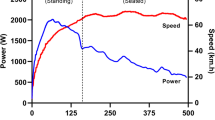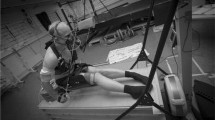Abstract
A friction loaded cycle ergometer was instrumented with a strain gauge and an incremental encoder to obtain accurate measurement of human mechanical work output during the acceleration phase of a cycling sprint. This device was used to characterise muscle function in a group of 15 well-trained male subjects, asked to perform six short maximal sprints on the cycle against a constant friction load. Friction loads were successively set at 0.25, 0.35, 0.45, 0.55, 0.65 and 0.75 N·kg−1 body mass. Since the sprints were performed from a standing start, and since the acceleration was not restricted, the greatest attention was paid to the measurement of the acceleration balancing load due to flywheel inertia. Instantaneous pedalling velocity (v) and power output (P) were calculated each 5 ms and then averaged over each downstroke period so that each pedal downstroke provided a combination of v, force and P. Since an 8-s acceleration phase was composed of about 21 to 34 pedal downstrokes, this many v-P combinations were obtained amounting to 137–180 v-P combinations for all six friction loads in one individual, over the widest functional range of pedalling velocities (17–214 rpm). Thus, the individual's muscle function was characterised by the v-P relationships obtained during the six acceleration phases of the six sprints. An important finding of the present study was a strong linear relationship between individual optimal velocity (v opt) and individual maximal power output (P max) (n = 15, r = 0.95, P < 0.001) which has never been observed before. Since v opt has been demonstrated to be related to human fibre type composition both v opt, P max and their inter-relationship could represent a major feature in characterising muscle function in maximal unrestricted exercise. It is suggested that the present method is well suited to such analyses.
Similar content being viewed by others
References
Aagaard P, Simonsen EB, Trolle M, Bangsbo J, Klausen K (1994) Moment and power generation during maximal knee extension performed at low and high speed. Eur J Applied Physiol 69:376–381
Andrews JG (1983) Biomechanical measures of muscular effort. Med Sci Sports Exerc 15:199–207
Arsac LM, Hautier CA, Belli A, Lacour JR (1995) Effect of sprint training on a cycle ergometer on the muscle power-velocity relationship measured during cycling. XVth Congess of the International Society of Biomechanics, Jyväskylä
Beelen A, Sargeant AJ (1989) Effect of fatigue on maximum short-term power output at different contraction velocities in humans. J Physiol (Lond) 409:82P
Beelen A, Sargeant AJ (1991) Effect of fatigue on maximal power output at different contraction velocities in humans. J Applied Physiol 71:2332–2337
Belli A, Lacour JR, Komi PV, Candau R, Denis C (1995) Mechanical step variability during treadmill running. Eur J Applied Physiol 70:510–517
Bosco C, Belli A, Astrua M, Tihanyi J, Pozzo R, Kellis S, Tsarpela O, Foti C, Manno R, Tranquilli C (1995) A dynamometer for evaluation of dynamic muscle work. Eur J Applied Physiol 70:379–386
Bottinelli R, Schiaffino S, Reggiani C (1991) Force-velocity relations and myosin heavy chain isoform compositions of skinned fibres from rat skeletal muscle. J Physiol (Lond) 437:655–672
Coyle EF, Costill DL, Lesmes GR (1979) Leg extension power and muscle fibre composition. Med Sci Sports Exerc 11:12–15
Daly DJ, Cavanagh PR (1976) Asymmetry in bicycle ergometer pedalling. Med Sci Sports Exerc 8:204–208
Davies CTM, Rennie R (1968) Human power output. Nature 217:770–771
Davies CTM, Wemyss-Holden J, Young K (1984) Measurement of short term power output: comparison between cycling and jumping. Ergonomics 27:285–296
Faulkner JA, Clafin DR, McCully KK (1986) Power output of fast and slow fibres from human skeletal muscles. In: Jones NL, McCartney N, McComas AJ (eds) Human muscle power. Human Kinetics, Champain, Ill, pp 81–94
Gaitanos GC, Williams C, Boobis LH, Brooks S (1993) Human muscle metabolism during intermittent maximal exercise. J Applied Physiol 75:712–719
Gregor RJ, Edgerton VR, Perrine JJ, Campion DS, Debris C (1979) Torque-velocity relationships and muscle fibre composition in elite female athletes. J Applied Physiol 47:388–392
Hautier CA, Linossier MT, Belli A, Lacour JR, Arsac LM Optimal velocity for maximal power production in non-isokinetic cycling is related to muscle fibre type composition. Eur J Applied Physiol (in press)
Jones NL, McCartney N, Graham T, Spriet LL, Kowalchuk JM, Heigenhauser GJF, Sutton JR (1985) Muscle performance and metabolism in maximal isokinetic cycling at slow and fast speed. J Applied Physiol 59:132–136
Lakomy HKA (1986) Measurements of work and power output using friction-loaded cycle ergometers. Ergonomics 29:509–517
Lakomy HKA (1988) Measurement of external power output during high intensity exercise. Loughborough University of Technology, Leicester, England
Lakomy HKA, Lakomy J, Martin D, Nevill ME (1994a) Fatigue and the power-velocity relationship of muscle measured during cycling. J Sports Sci 12:142
Lakomy HKA, Nevill Me, McKee D, Weller A (1994b) Physiological responses to two methods for examining repeated bouts of maximum short-duration exercise. J Sports Sci 12:142
McCartney N, Heigenhauser GJF, Jones NL (1983a) Effects of pH on maximal power output and fatigue during short-term dynamic exercise. JApplied Physiol 55:225–229
McCartney N, Heigenhauser GJF, Jones NL (1983b) Power output and fatigue of human muscle in maximal cycling exercise. J Applied Physiol 55:218–224
McCartney N, Heigenhauser GJF, Sargeant AJ, Jones NL (1983c) A constant-velocity cycle ergometer for the study of dynamic muscle function. J Applied Physiol 55:212–217
McCartney N, Obminski G, Heigenhauser GJF (1985) Torque-velocity relationship in isokinetic cycling exercise. J Applied Physiol 58:1459–1462
Perrine JJ, Edgerton VR (1978) Muscle force-velocity and power velocity relationships under isokinetic loading. Med Sci Sports Exerc 10:159–166
Sargeant AJ (1994) Human power output and muscle fatigue. Int J Sports Med 15:116–121
Sargeant AJ, Beelan A (1993) Human muscle fatigue in dynamic exercise. Neuromuscular fatigue. Elsevier, Amsterdam, 81–92
Sargeant AJ, Hoinville E, Young A (1981) Maximum leg force and power output during short-term dynamic exercise. J Applied Physiol 51:1175–1182
Sargeant AJ, Dolan P, Young A (1984) Optimal velocity for maximal short-term (anaerobic) power output in cycling. Int J Sports Med 5:124–125
Seek D, Vandewalle H, Decrops N, Monod H (1995) Maximal power and torque-velocity relationship on a cycle ergometer during the acceleration phase of a single all-out exercise. Eur J Applied Physiol 70:161–168
Thorstensson A, Grimby G, Karlsson J (1976) Force-velocity relationship and fibre composition in human knee extensor muscles. J Applied Physiol 40:12–16
Vandewalle H, Pérès G, Heller J, Panel J, Monod H (1987) Forcevelocity relationship and maximal power on a cycle ergometer: correlation with the height of a vertical jump. Eur J Applied Physiol 56:650–656
Williams JH, Barnes WS, Signorile JF (1988) A constant-load ergometer for measuring peak power output and fatigue. J Applied Physiol 65: 2343–2348
Author information
Authors and Affiliations
Rights and permissions
About this article
Cite this article
Arsac, L.M., Belli, A. & Lacour, JR. Muscle function during brief maximal exercise: accurate measurements on a friction-loaded cycle ergometer. Europ. J. Appl. Physiol. 74, 100–106 (1996). https://doi.org/10.1007/BF00376501
Accepted:
Issue Date:
DOI: https://doi.org/10.1007/BF00376501




